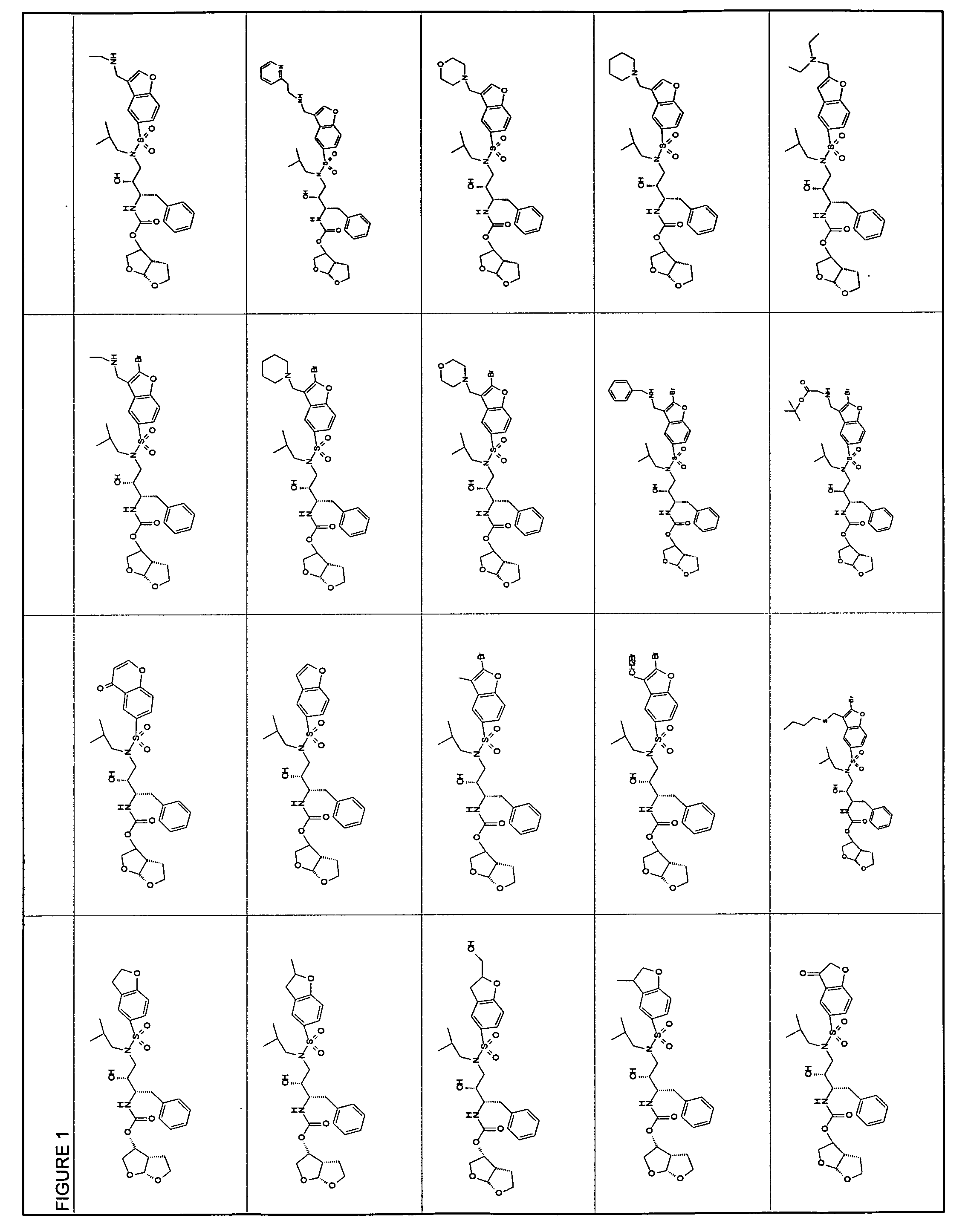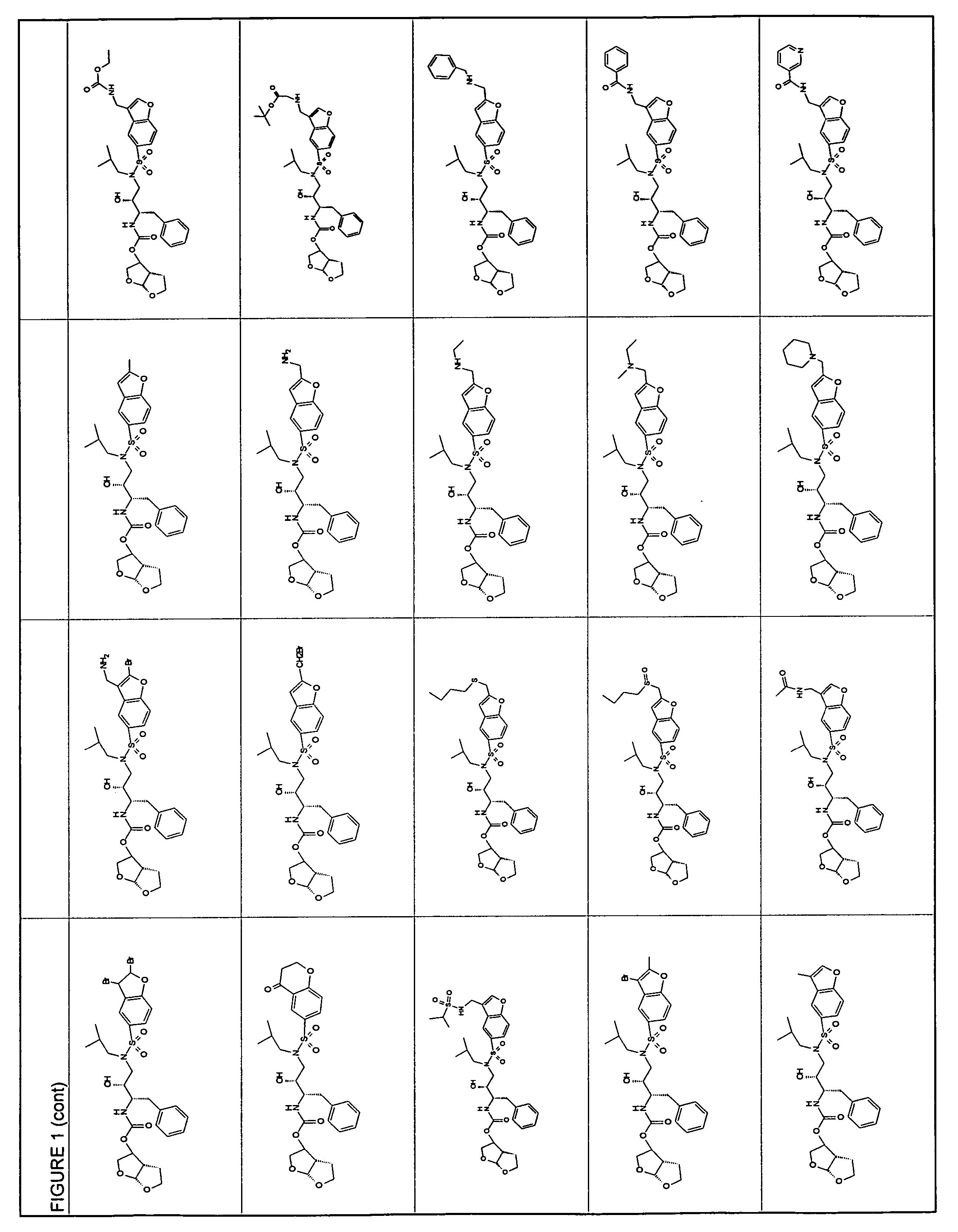Resistance-repellent retroviral protease inhibitors
a technology of resistance-repellent retroviral protease and inhibitors, which is applied in the direction of biocide, group 5/15 element organic compounds, drug compositions, etc., can solve the problems of neurological deterioration, severe compromising of the immune system, and death of the infected individual
- Summary
- Abstract
- Description
- Claims
- Application Information
AI Technical Summary
Benefits of technology
Problems solved by technology
Method used
Image
Examples
example 1
Preparation of Benzofuran-5-sulfonyl chlorides
[0472] Benzofuran-5-sulfonyl chlorides may be prepared by a bromination-dehydrobromination route as shown below:
[0473] 2,3-Dihydrobenzofuran-5-sulfonyl chloride was prepared from commercially available 2,3-dihydrobenzofuran as described in the patent EP 0583960A2.
Preparation of benzofuran-5-sulfonyl chloride
[0474] 2,3-Dihydrobenzofuran-5-sulfonyl chloride 300 mg (1.37 mmol) was dissolved in 2 mL of benzene. N-bromosuccinimide 244 mg (1.37 mmol) and 3 mg AIBN were added to the solution and the reaction was heated at 80° C. for 1 hour. The reaction was allowed to come to room temperature, filtered and the filtrate was concentrated in vacuo. The residue was purified by chromatography on silica gel (30% CH2Cl2 / hexanes) to afford 237 mg (80% yield) of the pure material.
[0475] 3-Methyl-2,3-dihydrobenzofuran was synthesized as described in the literature starting from 2-iodophenol (Organic Synthesis, CV3, 418; L. W. Menapace and H. G. Ku...
example 2
Preparation of Indazole-5-sulfonyl chlorides
[0479] Indazole-5-sulfonyl chlorides may be prepared by direct chlorosulfonylation of a protected indazole as shown below:
[0480] 3-Methylindazole J. Med. Chem.; EN; 40; 17; 1997; 2706-2725
1-(3-methyl-indazol-1-yl)-ethanone
[0481] 3-Methylindazole (1.00 g, 7.6 mmol) was dissolved in 10 ml THF and stirred at RT under a blanket of argon. Pyridine (0.64 ml, 7.9 mmol) was added followed by Ac2O (0.79 ml, 8.3 mmol) and catalytic DMAP (90 mg, 0.7 mmol). The reaction proceeded for 2 h and was then partitioned between 1N HCl and dichloromethane. The organic phase was dried over MgSO4 and concentrated in vacuo to a tan solid (1.2 g, 91% yield).
[0482] Ref: Chem. Ber.; 53; 1920; 1204
3-Methyl-1H-indazole-5-sulfonyl chloride (3)
[0483] To chlorosulfonic acid (0.38 ml, 5.7 mmol) under a blanket of argon in an ice bath was added 1-(3-methyl-indazol-1-yl)-ethanone (200 mg, 1.1 mmol). The reaction was allowed to warm to RT and then was heated at 70° C...
example 3
Preparation of Benzisoxazole-5-sulfonyl chlorides
[0484] Benzisoxazole-5-sulfonyl chlorides may be prepared by direct chlorosulfonylation of a suitable substituted benzisoxazole as shown below:
3-Bromomethyl-benzo[d]isoxazole
[0485] Benzo[d]isoxazol-3-yl-bromo-acetic acid (J. Med. Chem. 2003, 46; 5428-5436, Chem. Pharm. Bull.; EN; 26; 1978; 3498-3503) was slowly heated under argon with stirring to 130° C. and held there for 30 minutes. Copious gas evolution was observed during this time. The reaction was cooled to RT and the resulting brown crystals were filtered off and purified via column chromatography (hexanes), (2.3 g, 70% yield).
3-Bromomethyl-benzo[d]isoxazole-5-sulfonyl chloride
[0486] Chlorosulfonic acid (1.5 ml, 22 mmol) was slowly added to 3-Bromomethyl-benzo[d]isoxazole (1.0 g, 4.7 mmol) at RT under argon. The reaction was heated at 90° C. for 12 h and then left at RT for 6 h. The resulting viscous oil was quenched over ice, extracted with EtOAc, dried over MgSO4 and co...
PUM
| Property | Measurement | Unit |
|---|---|---|
| Molar density | aaaaa | aaaaa |
| Temperature | aaaaa | aaaaa |
| Temperature | aaaaa | aaaaa |
Abstract
Description
Claims
Application Information
 Login to View More
Login to View More - R&D
- Intellectual Property
- Life Sciences
- Materials
- Tech Scout
- Unparalleled Data Quality
- Higher Quality Content
- 60% Fewer Hallucinations
Browse by: Latest US Patents, China's latest patents, Technical Efficacy Thesaurus, Application Domain, Technology Topic, Popular Technical Reports.
© 2025 PatSnap. All rights reserved.Legal|Privacy policy|Modern Slavery Act Transparency Statement|Sitemap|About US| Contact US: help@patsnap.com



